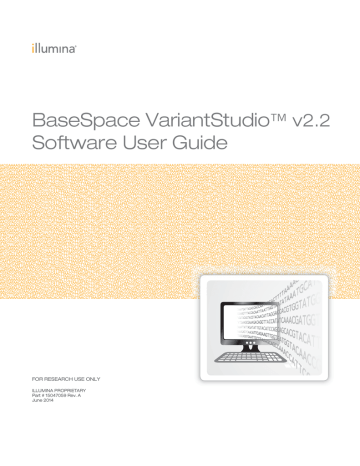- No category

advertisement

Annotate Variants
From the Annotations and Classification tab, use commands on the Annotate menu to annotate variants in the current sample with options to annotate all variants or only those variants specified. All coordinates used in BaseSpace VariantStudio are genomic coordinates on the positive strand.
Always annotate variants before applying filters.
NOTE
An internet connection is required to annotate variants. After annotating, an internet connection is not necessary.
Figure 13 Annotate Menu
Command
Annotate
Custom Annotation
Custom Gene
Annotation
Description
Annotates variants in the project using the following options:
• All Variants of Current Sample—Annotates all variants in the current sample. The current sample is listed in the
Current Sample field of the Samples menu.
• Exonic Variants of Current Sample—Annotates variants found within an exon plus 20 bp on either side of the exonic region to include the annotation of splice site variants.
• Selected Variants of Current Sample—Annotates only the variants that you have selected or filtered.
• All Samples—Annotates all variants within each sample imported into the project. This process can take time to complete depending on the number of samples in the project.
Opens a window to browse to the location of the custom annotations file for variant-level annotation. For more information, see
Input File for Custom Variant Annotations on page 29 .
Opens a window to browse to the location of the custom annotations file for gene-level annotation. For more information, see
Input File for Custom Gene Annotations on page 29 .
Opens a window that lists the default transcript for each gene and options for changing to other than the default transcript.
Set Default
Transcripts
NOTE
Although mitochondrial variants can be imported, the annotation database does not provide annotations for these variants.
26
Part # 15047059 Rev. A
Annotation Options
From the Annotate menu, click Annotation Options. The Annotation Options form opens with options to annotate only certain variants.
Figure 14 Variant Option Form
Option
Transcript Annotation
Transcript Source
Type
Forget BaseSpace
Logon
Description
Provides options to annotate only variants in the canonical transcript, which is the longest translated transcript in the gene, and variants in intronic regions.
Annotates variants identified in a specific annotation source, which is RefSeq, by default.
The default can be changed to Ensembl by editing the mode entry in the BaseSpace VariantStudio configuration file
(VariantStudio.exe.config), as follows:
<add key="Mode" value="Ensembl"/>
Close and reopen BaseSpace VariantStudio to enable the change.
Clears BaseSpace login information, such as ID and password.
Set Default Transcripts
1 Click Set Default Transcripts. A window opens that lists the default transcript for each gene. By default, BaseSpace VariantStudio lists the canonical transcript, which is the longest translated transcript in the gene.
2 For genes with multiple transcripts, use the drop-down list to set the default to another transcript.
BaseSpace VariantStudio v2.2 Software User Guide
27
Figure 15 Set Default Transcripts
28
Alternatively, click Browse to navigate to a tab-delimited text file containing your preferred default transcripts and click Load.
Input File for Default Transcripts
The input file for default transcripts requires two columns: Gene_Name and Transcript_
Name, as shown in the following example.
Gene_Name
ACTN3
ADH1B
AKAP10
Transcript_Name
NM_003793.3
NM_000668.4
NM_007202.3
Part # 15047059 Rev. A
advertisement
* Your assessment is very important for improving the workof artificial intelligence, which forms the content of this project
advertisement
Table of contents
- 5 Revision History
- 7 Table of Contents
- 9 Chapter 1 Getting Started
- 10 Introduction
- 12 VCF Input Requirements
- 14 BaseSpace VariantStudio Software Interface
- 17 Create or Open a Project
- 18 Import Variant Call Files
- 20 Data in BaseSpace VariantStudio Tables
- 29 VCF Fields Reported in the Variants Table
- 30 Somatic VCF Fields Reported in the Variants Table
- 33 Chapter 2 Applying Annotations and Classifications
- 34 Annotate Variants
- 37 Create Custom Annotations
- 39 Apply Variant Classifications
- 41 Edit Variant Classifications
- 43 Manage Classifications
- 45 Import Classifications
- 47 Chapter 3 Applying Filters
- 48 Apply Filters
- 57 Family-Based Filtering Workflows
- 63 Create Favorite Filters
- 65 Chapter 4 Generating Reports
- 66 Introduction
- 67 Sample Report Overview
- 68 Create a Sample Report Template
- 70 Create a Sample Report
- 71 Export Text Files and Charts
- 73 Appendix A Annotation Sources
- 74 Annotation Sources
- 77 Index
- 79 Technical Assistance